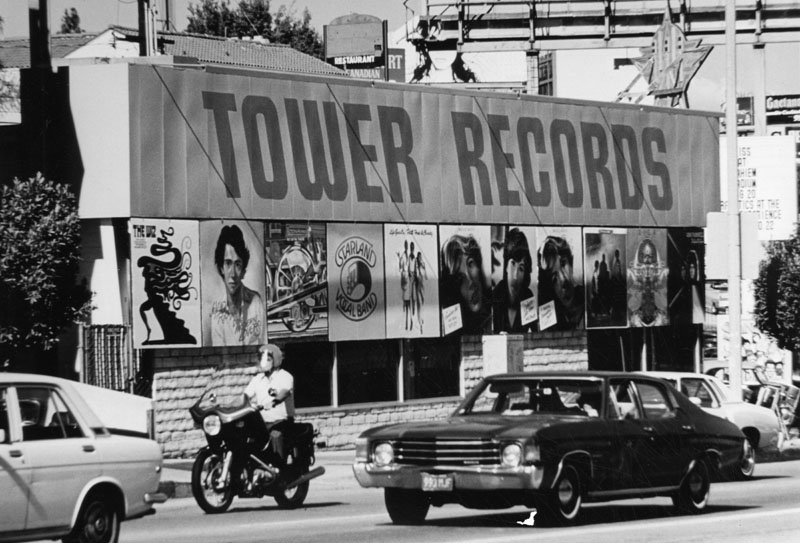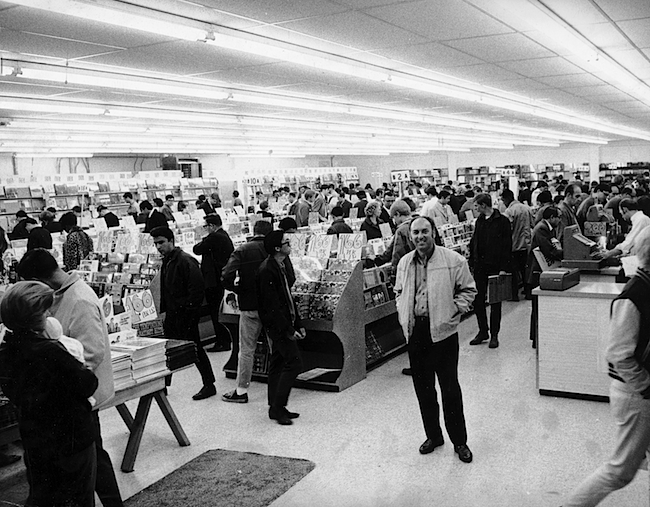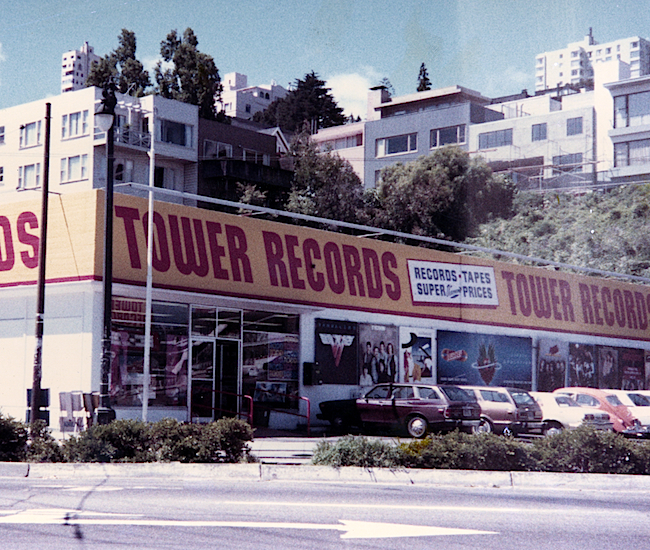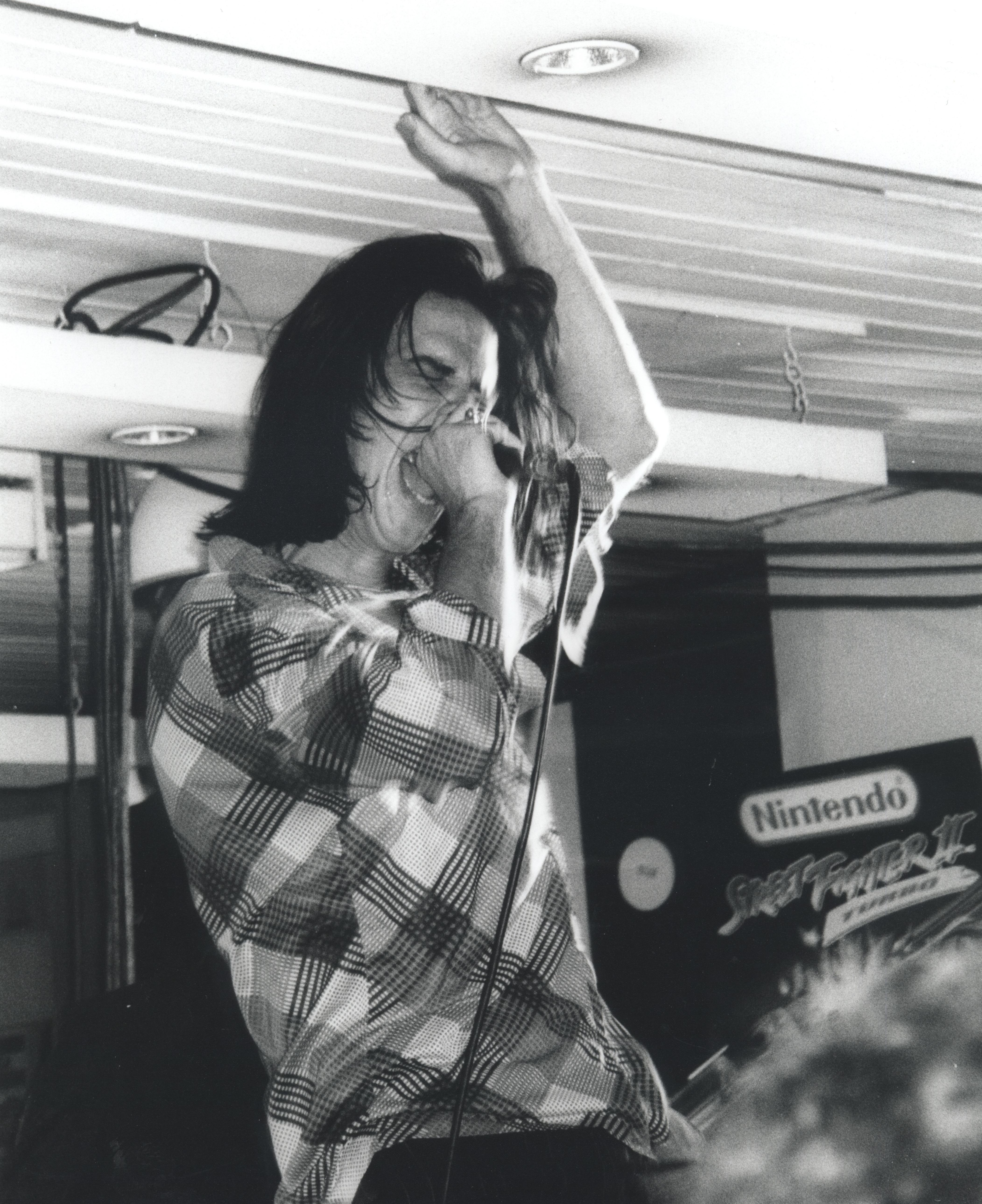Listening to music is a deeply personal experience. Some songs will always make certain people happy, while those same tunes will just as reliably make other people cry. Incredible as it may seem today, the mundane act of acquiring music also used to be personal, or at least required a personal investment: You’d hear a song on the radio or see a band at a local dive, decide you want more, and then make your way to your favorite record store to buy an LP or 45. Physical effort was required, as well as time and—ahem—money.
“If you were cool, you were cool. If you were an asshole, then you got treated like an asshole.”
Turns out that working in a record store was equally personal for the folks behind the counter, in the stock room, or out at corporate HQ, as the 2015 documentary, All Things Must Pass, directed by Sacramento, California, native Colin Hanks, so movingly explains. Hanks’ subject is his favorite hometown record store, Tower Records, which began its climb to global dominance in 1941, when a Sacramento teenager named Russ Solomon and his druggist father, Clayton, sold used 3-cent jukebox 78s to their soda-fountain customers for a dime.
From these humble roots grew the international empire of Tower Records. In 1961, the younger Solomon opened the first official Tower Records, complete with its famous red-on-yellow signage, on Sacramento’s Watt Avenue. In 1968 and 1970, Tower opened larger locations in San Francisco and Los Angeles, respectively. The first of a string of immensely profitable stores in Japan followed in 1979, and then, in 1983, the company opened a four-story temple to music in one of the most run-down sections of New York City. As with the locations in San Francisco, L.A., and throughout Japan, the New York City Tower was an enormous success.
By 1999, Tower was operating more than 150 stores in almost two-dozen countries, generating annual revenues of a billion dollars. But in 2004, the company was forced into bankruptcy, a victim of its own unchecked appetite for expansion, cutthroat competition from consumer-electronics retailers, tone-deaf marketing decisions on the part of the record industry, and viral file-sharing applications like Napster. Two years later, in 2006, Tower’s assets were unceremoniously liquidated. In Hanks’ film, grown men and women, who as twentysomethings had gleefully hopped aboard what was called “the Russ Bus,” openly weep at the memory of their beloved company’s catastrophic demise.
I get that, because as a kid in the late 1960s and early ’70s, my favorite place to buy music was the Tower in San Francisco, which consumed the corner of Columbus Avenue and Bay Street. I bought plenty of records at other places—the Record King in San Rafael and Village Music in Mill Valley got a fair amount of my pocket money—but Tower was always the most fun. It was 5,000 square feet of wall-to-wall vinyl, as far as the eye could see. Imagine if iTunes was an actual store you could wander around in for as long as you liked, with music blaring the whole time. That was Tower.

The first Tower Records was operated out of a drugstore in Sacramento, California. (Image courtesy Gravitas Ventures)
Here’s the thing about music in 2016, though: While it’s easy for me to get all nostalgic about Tower Records because I have so many fond memories of the place, my youngest son, Tom, and his friends couldn’t care less. I know this because I sat them down the other evening and forced them to watch Hanks’ film.
“I liked the documentary,” says Tom, age 25, whose own fond memories include our father-son bicycle rides to Tower to shop for CDs in the early 2000s—when the chain was already on the ropes—but not necessarily the shopping itself. “I liked seeing that there was a story behind the store,” he continues, “but that was never my perception of Tower, ever. It never felt like what they were showing in the movie, a place where people hung out and talked about music all the time. My memory of Tower Records is of a big, dumb chain store where you had to spend multiple week’s allowance to buy one album.”
Ouch. Maybe it would be better to begin this trip down memory lane with Solomon, whose recollections stretch to happier times, all the way back to 1938, when his dad opened a drugstore next door to the Tower Theatre in Sacramento, which is how the business got its name. “I was 13,” he tells me over the phone when we chatted the other day. “I was basically there all the time, sweeping the floor, putting stuff away.” When Clayton installed a soda fountain, his son Russ worked that, too. “I learned how to make milkshakes and ice cream sodas, things like that,” he says. In case you are wondering, his favorite treat was a chocolate-covered frozen banana.
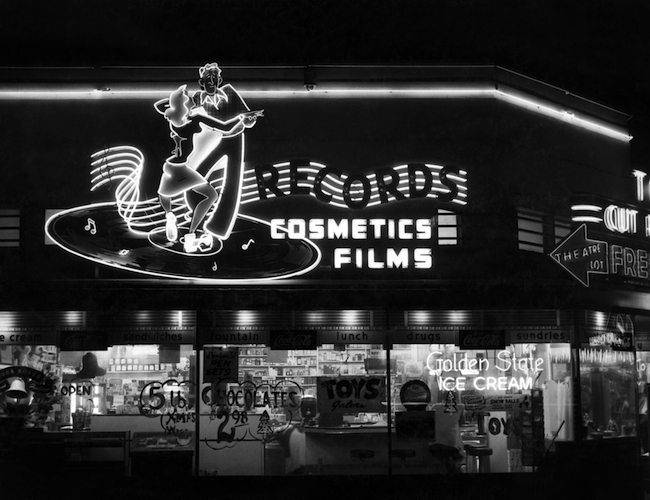
The neon sign advertising records and other items for sale at Russ Solomon’s father’s Sacramento drugstore. (Image courtesy Gravitas Ventures)
Musically, Solomon was a big-band guy—“I loved Tommy Dorsey”—although in “All Things Must Pass,” Solomon recalls that the first record he ever bought was the country-swing hit, “San Antonio Rose” by Bob Wills. After serving stateside in the Air Force during the final years of World War II, Solomon returned home and poured his energies into the record side of his father’s business, spinning 78s and then 45s for customers on a suitcase-size Magnavox record player, which had an amplifier and speaker built right in.
Solomon, though, wanted to set out on his own, and after a false start as a record wholesaler, in 1961, he opened the first Tower Records on Watt Avenue, with its distinctive, visible-from-space lettering designed by Mick Michelson. A Tower Books followed in 1976, also in Sacramento, but Solomon had bigger ambitions for his Sacramento-based brand.
“I always wanted a record store in San Francisco,” he says of the city where he was born but never lived. “And I always wanted it to be along Bay Street.” Weirdly, he found his perfect location one hungover morning after a boozy night in San Francisco with a Sacramento manicurist, whose name has been lost to the haze of history. In “All Things Must Pass,” Solomon recounts the story of attempting to soak up the alcohol in his system with a “big, greasy breakfast,” when he looked up and noticed a vacant building across the street, at the corner of Columbus and Bay—with parking, no less. Walking over to the payphone outside the empty shell, he dialed the number on the “For Lease” sign and made a deal for it on the spot.
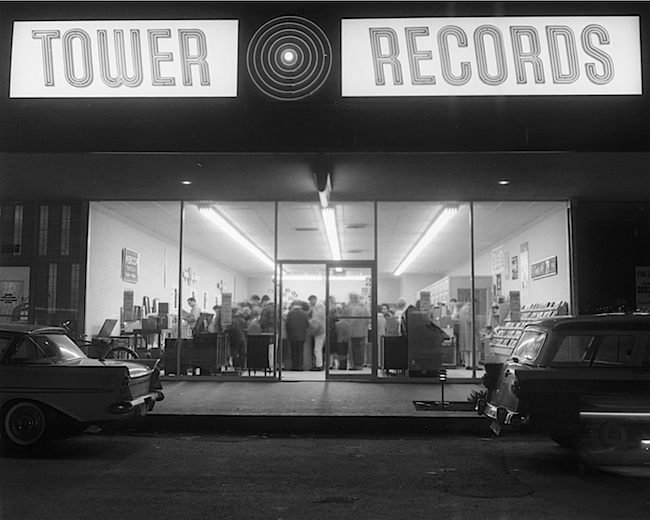
Russ Solomon’s first official Tower Records opened in 1961 on Watt Avenue in Sacramento. (Image courtesy Gravitas Ventures)
It was the fall of 1967, a few months after the Summer of Love. At that point, San Francisco was well-known nationally as the home of the Haight-Ashbury, whose most famous residents were considered the city’s rock royalty. They shopped for amplifiers and guitars up the street from Tower at Don Wehr’s Music City. North Beach, with jazz clubs like Basin Street West, was just a few blocks beyond that. Heading west through the Broadway tunnel was the Avalon Ballroom and Fillmore Auditorium, where bands like Cream, Pink Floyd, and The Doors came to play. By the time Tower Records opened its doors in San Francisco in the spring of 1968, it immediately became a part of this intensely vibrant musical community.
“I went to the Fillmore a couple of times,” Solomon tells me. “The Grateful Dead, Jefferson Airplane—that was our scene. I remember one time for the release of a Grateful Dead album on Warner Bros., we decided to get a coffin and put somebody in it—I don’t remember who. They carried the coffin around the store and then opened it up, and this guy jumped out. We did a lot of nutty things like that.”
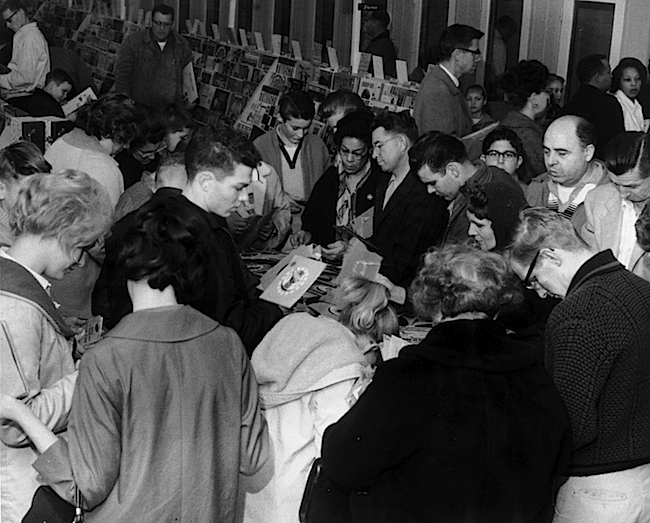
The 10-cent-singles counter at the Watt Avenue Tower Records, circa 1962. (Image courtesy Gravitas Ventures)
Nor were the fun and games limited to the promotion of rock releases. Tower also made its classical-music fans feel welcome. Stan Goman, who helped Tower open its marquee stores in both San Francisco and Los Angeles before becoming the chain’s Chief Operating Officer, remembers how appreciative the city’s classical-music fans were of the store’s enormous selection.
“We probably sold more classical records out of that place than any other store in the country,” Goman says. “Probably 20 or 25 percent of the store was classical.”
Tower nurtured the classical-music community, and moved merchandise, by regularly hosting special events. “We had some great ‘in-stores,’” Goman says, lapsing into record-retailing lingo. “The classical people were a gas. Pavarotti came three or four times to San Francisco—he would sign autographs forever. Beverly Sills was also a sweetheart. And Itzhak Perlman’s knowledge of oldies, stuff like Chuck Berry, was encyclopedic. After an artist had finished signing for a huge line of like 300, 400 people, we’d get a bunch of local wine and just give it out free. The artists, the store crew, everybody would get pretty toasty.”
My first recollection of Tower also concerns classical music, and it dates from the year the San Francisco store opened, 1968. Even though I lived in Marin County on the other side of the Golden Gate Bridge, I had a good friend in San Francisco named Mike Basayne, whose dad, Hank, was one of the owners of a legendarily beloved restaurant on Union Street called the Coffee Cantata.
“Napster, as Hanks’ film makes clear, was not even the biggest factor in Tower’s demise.”
As the second part of its name suggests, the Coffee Cantata treated its customers to a continuous soundtrack of classical music, which Hank acquired from Tower Records. For free. Hank would buy an armful of classical records, carefully record them onto a reel-to-reel tape player, and then return the records for a refund, which he would apply to a new batch of vinyl. Even though Hank was not a paying customer, he was valued by the clerks at Tower, who would rewrap Hank’s played-once records and sell them again, a common practice in those days.
“We had a policy,” Goman says, confirming my childhood recollection. “If you didn’t like it, you could bring it back. The rock people were probably a little more policed, if you will. They took advantage more, and when they did, there was a little technique where you would run your fingernail on the bottom of the record while you were looking at the top, turn it over and say ‘Oh look, a scratch! We can’t give you a refund.’ But guys like Hank were kind of like family. I’m sure no one ever paid for a cup of coffee at the Coffee Cantata.
“If you were cool, you were cool,” Goman adds. “If you were an asshole, then you got treated like an asshole.” My friend Mike will be happy to know that, apparently, his dad was cool.
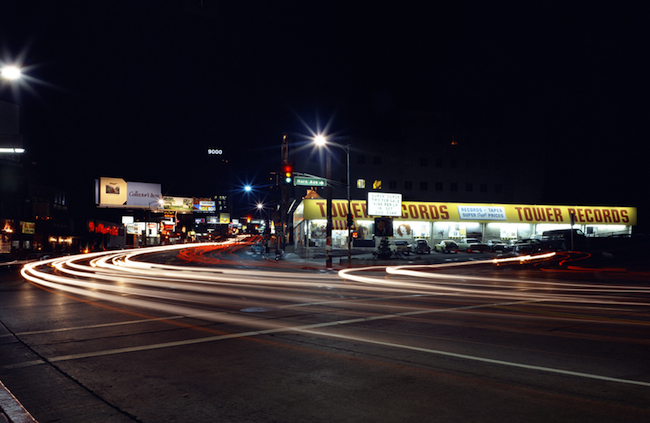
For more than 30 years, Tower Records was one of the most prominent landmarks on the Sunset Strip in Los Angeles. (Image courtesy Gravitas Ventures)
If that mixture of family atmosphere and street-smart attitude was what Tower was known for inside its stores, the exteriors of the San Francisco and Los Angeles branches were famous for their oversize paintings of album covers. “That was an evolution,” Solomon says. “We had this big white wall in San Francisco. A guy named Bud O’Shea, who was a promotion man at the time for Columbia Records, asked if he could paint an advertisement for Billy Joel on it. It wasn’t even the album cover, just Billy Joel’s face and the name of whatever the record was. I said fine, as long as he painted it white again after a few weeks. Well, the minute that one came down, some other promotion man wanted the space.”
The first company contracted to do the painting for Tower was Alice in Wonderwalls, whose artists would paint whole album covers directly on the wall. “They literally had painters working on scaffolding,” Solomon recalls. “After a while, another company did the work in a studio, painting on big boards and then hanging the boards on the wall.” That company was called Art for Art’s Sake, the second “Art” being the first name of Art Newmark, whose brother David was a promo man for RCA, who—of course—knew Solomon.
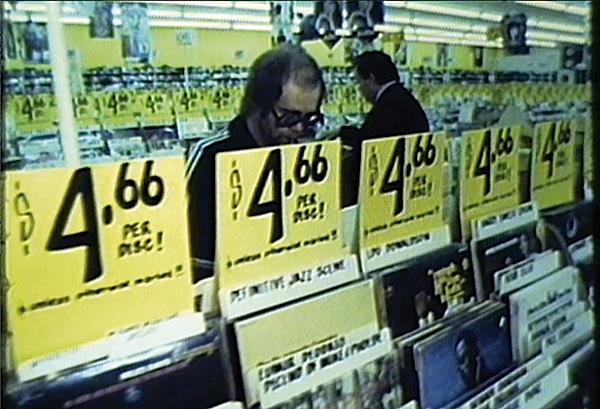
One of Tower’s most loyal customers in Los Angeles was Elton John, who states in “All Things Must Pass” that he probably spent more money in Tower Records than any other individual. (Image courtesy Gravitas Ventures)
One of the artists who painted album covers for Art for Art’s Sake, and hence Tower, was Alan Bonds, who raced mountain bikes on weekends but was a professional artist during the week—yes, being an artist was his day job. Bonds painted hundreds of album covers for Tower between 1977 and 1981. “I had answered an ad for airbrush artists,” Bonds recalls of his start. “They gave me a board to paint to see if I could do it. Fortunately, it was a really easy one, The Kinks’ “Sleepwalker” album, with Ray Davies as a mime in whiteface against a black background. Everyone liked it, so they put it up. Someone stole it the first night it was on the wall, so my future was secure.”
For much of his time painting for Tower, Bonds worked alongside two other artists, including a painter named Kaye St. Morris. “Kaye was a really accomplished brush painter,” Bonds says, “who knew all about mixing Liquitex colors. She taught me color-blending, and I taught her how to use a Paasche airbrush.”
The process was fairly simple. The first step was to spray a coat of white primer on the boards, which were 6-by-6 feet, made of Masonite, and secured to frames made of 2-by-2s. “We worked in a two-car garage,” Bonds says, “with a projector against the far wall so we could project the album covers onto the white boards. From there you’d line them out in the dark. You couldn’t draw everything exactly, and the details weren’t always crisp because of the distance from the projector, but you could pretty much plot your marks so that you knew where the corners of a mouth were, nostrils, the corners of eyes, important stuff like that.”
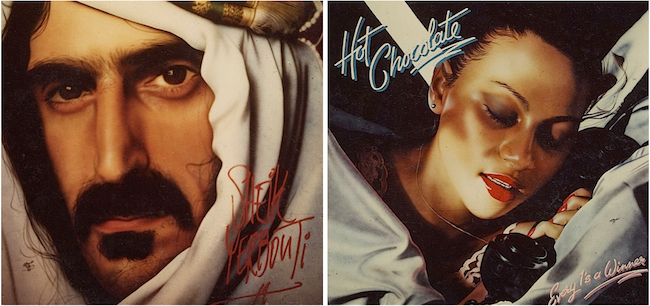
Alan Bonds airbrushed 6-by-6-foot album covers such as these for Tower’s San Francisco store from 1977 to 1981.
Bonds and his colleagues worked quickly, in part because an artist would only get about $400 for a completed board. “I think I might have done some in 5 or 6 hours, others took as long as 9 or 10. I generally painted three a week, sometimes four.”
Once their multi-week lifespan outside Tower was over, the boards would be returned to the garage, where Bonds and his colleagues would shoot them with primer again and begin another album cover. “Eventually, the boards had to be replaced,” Bonds says, “because they’d get so loaded down with paint—the surfaces weren’t good to work on anymore. But I kept six or eight of the good ones, and replaced the boards I kept out of my own pocket.” Keepers included Steve Miller’s “Book of Dreams,” whose original album art was created by rock-poster artists Alton Kelley and Stanley Mouse, Frank Zappa’s “Sheik Yerbouti,” and the cover of the eponymous first album by The Cars.
While Bonds remembers regular requests from label reps who wanted to see their acts on Tower’s wall—“such and such band was going to be in town, so they’d want me to get a board up in a couple of days so the band could drive by and see it”—Tower never made a penny from record labels for giving their products such prime placement. “We didn’t charge them anything,” Solomon says. “But it made the store look good and was a good advertisement for the album.”
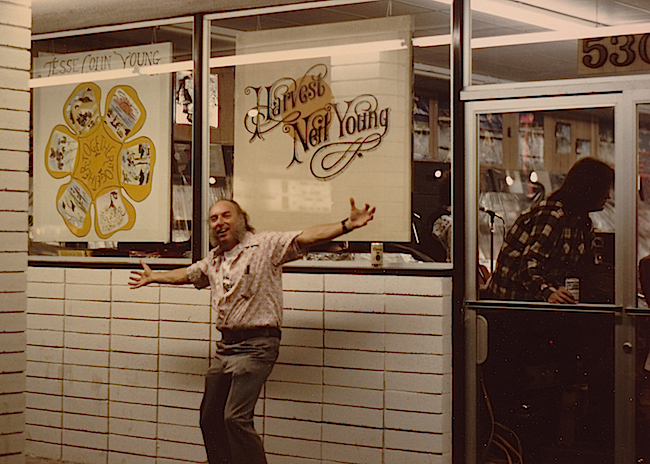
Russ Solomon at the Fresno, California, Tower Records in 1972. Using album art to market merchandise was always part of the Tower strategy. (Image courtesy Gravitas Ventures)
“We never sold the space,” Goman confirms. “Everybody thought we did, but Russ didn’t want to deal with it. The record company just paid Art for Art’s Sake, which paid the artists, and we stayed out of it. Hindsight being 20/20, we probably should have charged something, but we didn’t.”
As Tower grew, young adults in cities other than Sacramento, San Francisco, and Los Angeles got their chance to become a part of Tower family and get on the Russ Bus, which according to most of the people interviewed for “All Things Must Pass” meant sneaking off for cocktails during extended lunch hours, snorting coke to stay awake during all-night inventory sessions (famously expensed as “Hand Truck Fuel”), and wearing, well, whatever they wanted. In the documentary, Dave Grohl of the Foo Fighters explains that his love for the Tower he worked at in Washington, D.C., stemmed in no small part from the fact that he didn’t have to cut his hair in order to be employed.
One of the first places outside of California where Tower expanded was Phoenix, Arizona, which is where, in 1983, screenwriter Carol Heikkinen, then a senior in high school, worked for Tower in the video department. “My best friend, Caroline, worked at the Tower Records near the Chris-Town Mall,” Heikkinen remembers. “I went to visit her at work one day and she said, ‘Hey, they’re opening up a video department. If you want a job, you should talk to the manager because he’s here right now.’ So, I went over and talked to him and basically got the job just like that.” Though she didn’t know it at the time, her Tower experiences, which would continue through college, would eventually inform her screenplay for the 1995 cult hit, “Empire Records,” her second film.
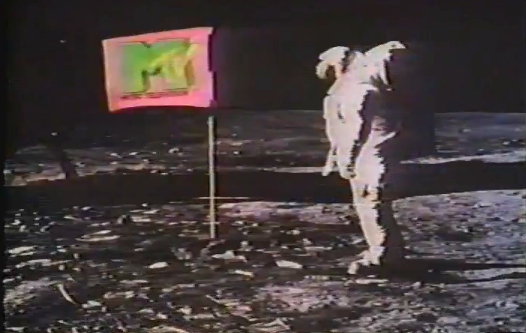
In 1981, the launch of MTV was the first in a series of events that saved the record industry from the financial catastrophe known as disco.
When Heikkinen started working at Tower, as “All Things Must Pass” explains, the music industry was enjoying a redemptive rebirth after the disco craze of the late 1970s spectacularly peaked, and just as spectacularly crashed, almost taking the record industry with it. What saved the business, according to Steve Knopper of “Rolling Stone,” who is interviewed for Hanks’ film, were several game-changing events.
The first was the birth of MTV, which launched in 1981 and contrary to the lyrics of a prescient 1979 Buggles song, the channel’s music videos did not kill the radio star. Instead, the music network sent people into record stores to buy the songs they were watching being acted out on MTV. Hot on the heels of MTV was another technological breakthrough, the music CD, which, beginning in 1982, gave several generations of vinyl collectors countless reasons to upgrade their collections to the new, cleaner-sounding format. And then, of course, there was the 1982 smash album by Michael Jackson called “Thriller,” which lured millions of people into record stores, some of them for the first time in years.
So, even though Heikkinen missed the launch of Tower in Sacramento and the openings of Tower stores in San Francisco and L.A., she was definitely at Tower when the company was on the rise, and, more importantly, when music was once again considered cool. “I was always a clerk,” Heikkinen says of her time at the chain, explaining the lens through which she viewed the company. “In my senior year of high school, I only went to class half a day so I could work at Tower more or less full-time. When I came home from college, Tower was my summer job.”
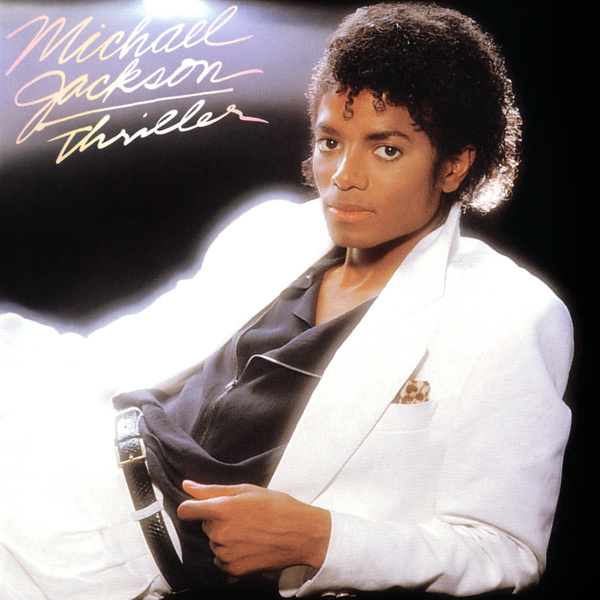
Michael Jackson’s “Thriller” from 1982 lured people who hadn’t bought a new album in years into record stores.
Eventually, Heikkinen made it to the hallowed clerk counter at the Tower campus in Los Angeles. A few years after graduating from high school, while doing a summer internship in L.A. between her junior and senior years at Syracuse University, Heikkinen landed a job at Tower Video on Sunset Boulevard, which was located across the street from the original Tower Records. “Everything was under one roof in Phoenix,” Heikkinen says, “but in L.A., Tower Video was next door to Tower Classical. We shared the break room but I didn’t know any of the classical clerks. They were slightly older and more serious, because, you know, they were listening to classical music all day. They were a different breed.”
It was only later that Heikkinen realized her time at Tower was good material for a movie. “I remember having this idea pop into my head of doing a movie like ‘Carwash,’ but setting it in a record store,” she says. “The characters in ‘Carwash’ were kind of like a family, just like at Tower. They supported each other.”

Kupferman Horowitz Lyn Kupferman, right, and her friend Shiela Horowitz wait as a Tower Records clerk rings up the purchase of over $200 in Beatles and John Lennon albums, in Los Angeles.8 Dec 1980
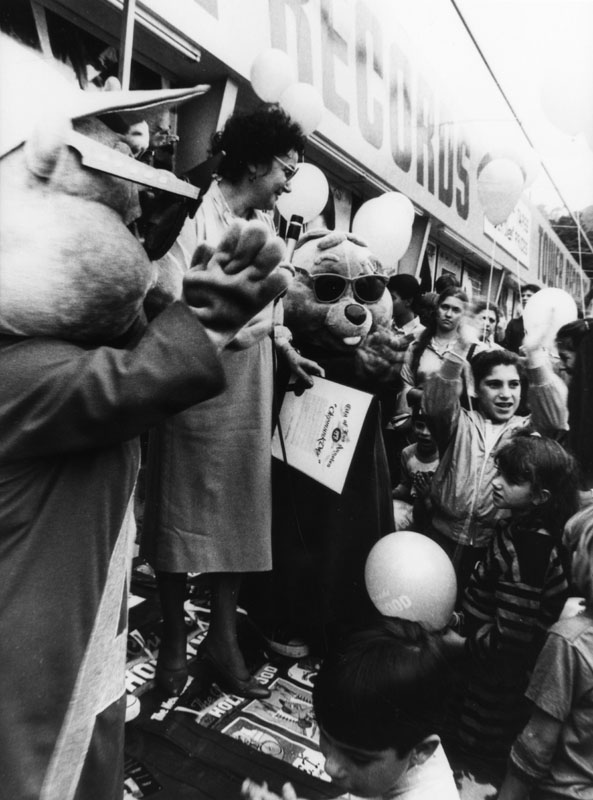
A “Chipmunk Day” sales promotion at Tower Records on Sunset Strip, including a presentation in honor of the event by the City of Los Angeles. Photograph dated October 25, 1982.

Missy Coltenback of Secaucus, N.J. holds the five-record album set by rock singer Bruce Springsteen as it went on sale at Tower Records in New York, . Entitled “Bruce Springsteen & the E Street Band Live–1975-85,” the 40-song set is expected to set record sales – 10 Nov 1986
Beyond this overall sensibility, Heikkinen’s Tower years gave her lots of rich anecdotes to add authenticity to the actions of her characters. “At Tower, there was this story going around about a night manager who had taken all the money at the end of his shift and gone to Vegas with a girl. The way I heard it, he didn’t even get fired. Years later, I found out he did, but he was never arrested. For me, the specifics mattered less than the idea that it was really, really hard to get fired from Tower. It was like, you don’t fire a member of your own family.”
In “Empire Records,” the character who rises from this anecdote is Lucas, who makes off with $9,000 from the Empire cash register at the end of a day and blows it all in Atlantic City. His motivation is to save Empire Records from being bought out by a big chain store called Music Town, whose red-lettering-on-yellow-background logo bears more than a passing resemblance to Tower’s.
This, Heikkinen takes pains to point out, was not in the first draft of her script. She even sent me a copy of her script to prove it. In that 1994 document, Lucas only steals $8,000 and blows it all in Las Vegas because, as he glibly puts it, “It was inevitable.”
“That was the first thing I rewrote for Warner Bros.,” Heikkinen says. “Allan Moyle, the director, and I worked on that. The studio wanted us to raise the stakes. They didn’t tell us to write a corporate takeover, but they were, like, ‘What are the stakes for this money?’ So Allan and I came up with the idea that rather than Empire being a cool record store like Tower that was already part of a chain, it would be an independent record store that was going to be taken over by a chain.”
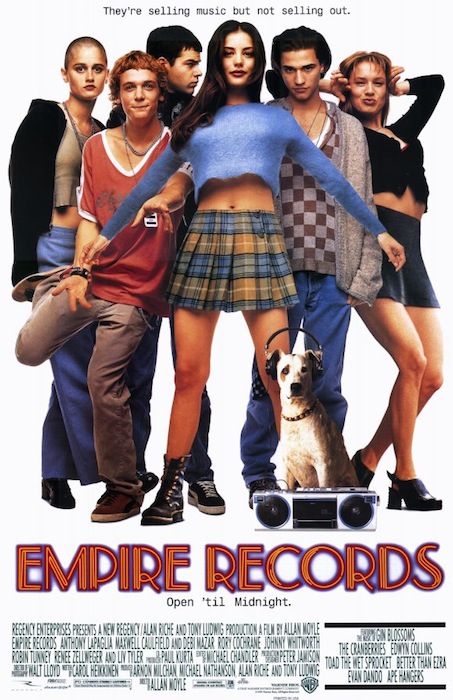
The first draft of screenwriter Carol Heikkinen’s script for the 1995 film “Empire Records” was supposed to take place in a Tower-like store, but the final movie made a Tower-like chain the enemy.
Here’s the curious thing, though, which illustrates how personally people can take music and even the prosaic experience of shopping for it: For my son and his friends, who must have watched “Empire Records” 100 times on the TV set in our living room, they always assumed that Heikkinen’s beloved Tower Records was the chain that was going to take over, and ruin, Empire.
Until I spoke with her the other day, Heikkinen had never considered that her movie, a love letter in her mind to Tower, would send that message. “I don’t understand,” she says when I explain to her how my son and his friends had interpreted her movie. “Tower was the villain? Did they not like going to Tower Records?”
I point out that Tom was only 9 when he and I first started riding our bicycles to Tower to spend our respective allowances on CDs. Napster had been released the year before. From Tom’s standpoint, Tower was always an old-school chain store that was on its way out.
“That’s so weird,” Heikkinen says. “And he watched the documentary?”
He loved the documentary, I assure her, concerned now that my revelations about Tom’s take on her movie—which, for the record, he still loves—might have caused her pain. But I have to ask her about the Music Town logo and its Tower-like colors. Hadn’t she noticed the similarity? “I never even thought about that,” she answers slowly. “I never thought about it,” she repeats, as if suddenly realizing that she may have had an unwitting hand in firing a member of her own family.
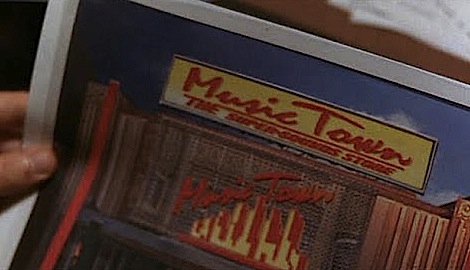
In “Empire Records,” the predatory record chain was called Music Town, whose red-on-yellow logo was lifted from Tower’s.
To be clear, the decline and ultimate collapse of Tower Records was not Heikkinen’s fault—far from it. In fact, “Empire Records” doesn’t even bear a mention in “All Things Must Pass.” That’s because Tower did a fairly spectacular job of screwing itself, as Solomon, Goman, and the other former executives and employees of Tower so candidly explain. By 1995, when “Empire Records” was released, Tower was smart enough to launch a Website, but expanding offline, in the real brick-and-mortar world, was still its focus. That expansion would lead to that billion-dollar-revenue year in 1999, but just as the early 1980s had provided a perfect storm of circumstances for the rebirth of the music industry, the late 1990s and early 2000s would deliver a perfect storm for its demise.
Napster, as Hanks’ film makes clear, was not even the biggest factor. Sure, it allowed people to get music for free, but it would not have been so attractive to consumers if the record companies, with the complicity of chains like Tower, had not insisted on keeping the prices of CDs high and discontinuing the practice of selling singles, which is what music consumers had been buying since Russ and Clayton Solomon sold their customers used 3-cent 78s for a dime.
“The 78,” Solomon says, “which morphed into the 45 in the 1950s, was really the lifeblood of the record business. It was all about singles. When the record companies decided not to make singles anymore, I think that was the beginning of the downfall of the industry. They were taking away what the kids really wanted by forcing them to buy an album. That was a big mistake.”
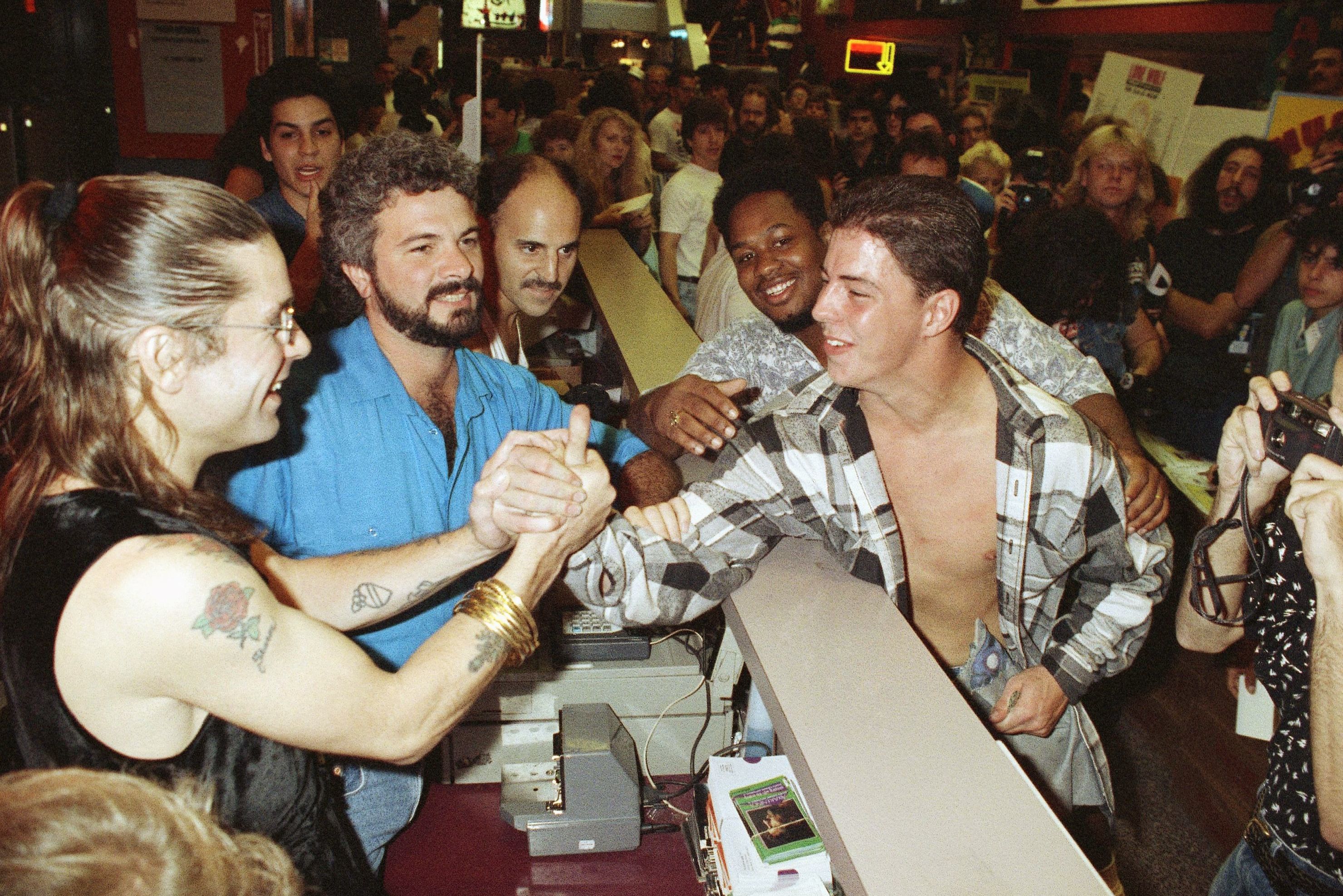
Rocker Ozzy Osbourne greets fans at Tower Records in downtown Manhattan, New York, while kicking off the release of his new album “No More Tears.” Osbourne surprised the crowd of some 200 people gathered at the store to purchase the long awaited Guns and Roses albums “Illusion I” and “Illusion II” which went on sale at midnight. 17 Sep 1991
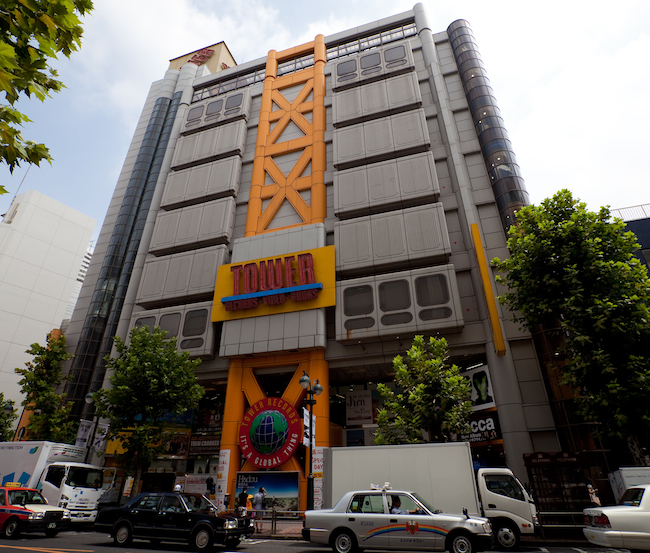
Today, Tower Records still exists, but only in Japan, having been sold off to raise cash at the start of Tower’s financial woes. The Shibuya store in Tokyo is the largest of the Japanese chain’s 85 outlets and is thought to be one of the biggest music stores in the world. (Image courtesy Gravitas Ventures)
“To me,” says my son Tom, “one of the cooler parts of the documentary was seeing how the market changed. For a while, Tower sold singles and LPs, then singles on cassette, and then the record companies got greedy, didn’t sell many singles as CDs, and raised the price of CDs. So, when MP3s came along, you could suddenly get singles again. The greed of the record companies probably had the biggest impact on encouraging music piracy. You’ll notice that today the market is all about singles.” On this, Russ Solomon and no less an authority than former record producer David Geffen, who is also interviewed for Hanks’ film, wholeheartedly agree.
Tower’s unchecked expansion and the record industry’s greed were self-inflicted wounds, but there was a third factor other than Napster that helps explain why Tower went broke—competition. One of the characteristics of CDs is that they are smaller than LPs, which means you can put more of them in the same amount of space in a store. And as “Thriller” had shown, hits lured people into stores. To put it simply, consumer-electronics retailers, and even big-box chains like Walmart and Target, decided they wanted a piece of this action.
“Walmart and Target didn’t sell enough to bother us,” Solomon corrects me. “But Best Buy did. They sold CDs, videos, and video games to draw people into their stores to look at their electronics and televisions.”
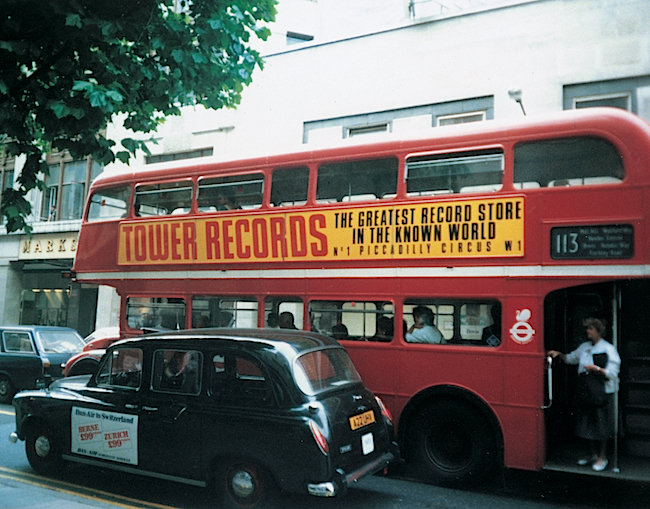
The flagship Tower Records in London at Piccadilly Circus opened in 1985. It closed in 2009. (Image courtesy Gravitas Ventures)
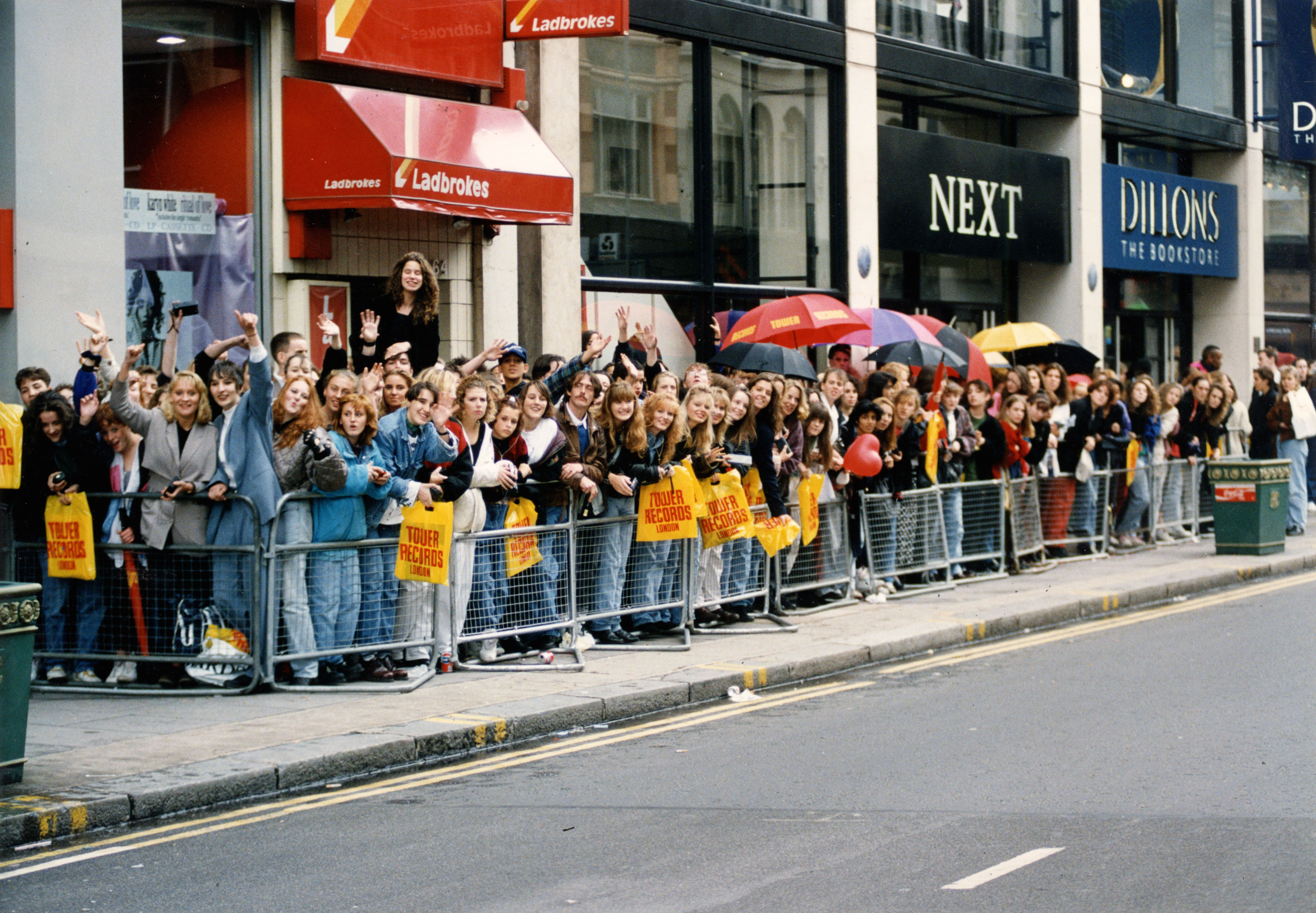
Bros Fans Queue Outside Tower Records In Kensington Where Bros Were Making A Personal Appearance – 29 Sep 1991
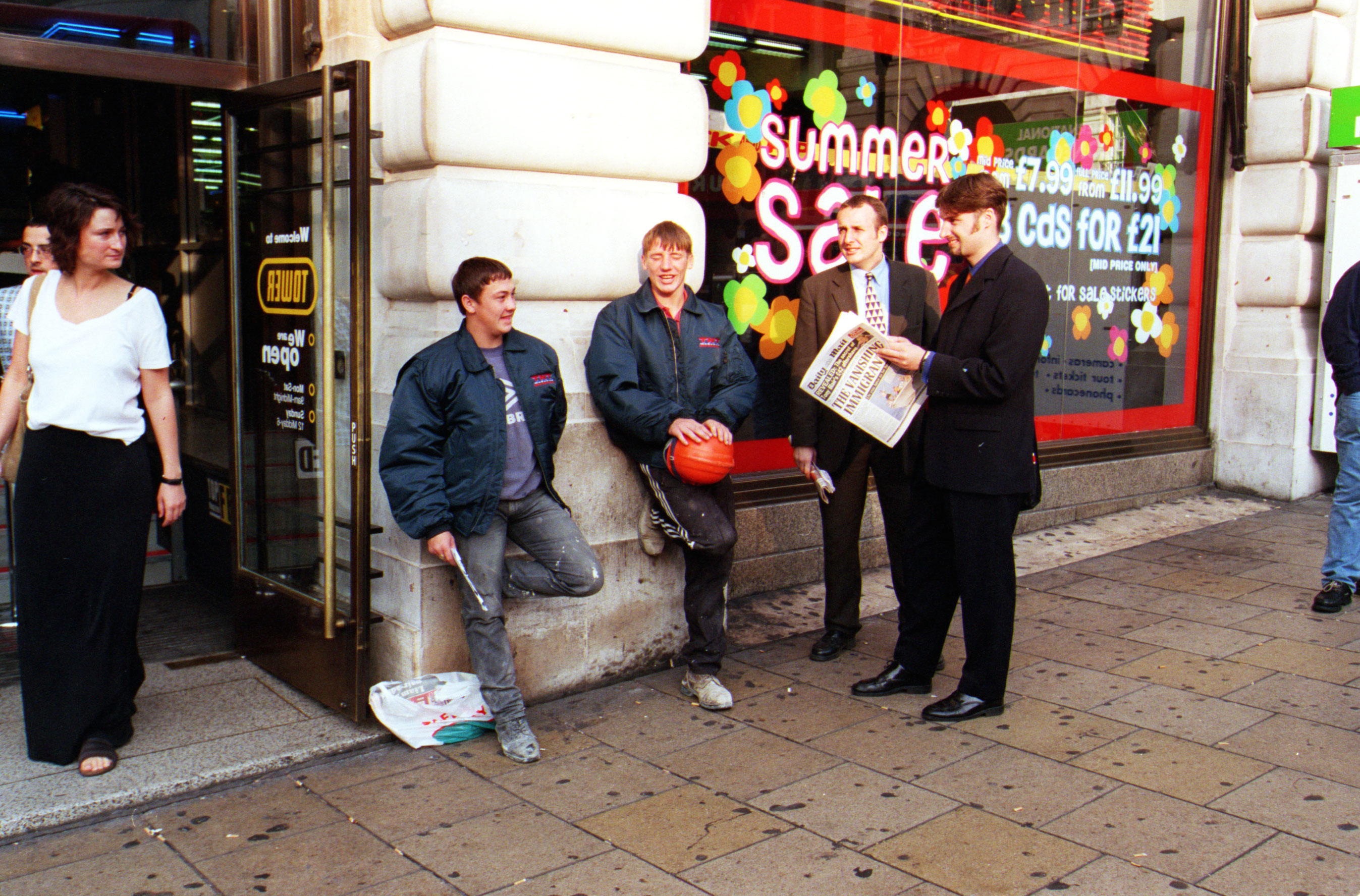
The New Record Called ‘be Here Now’ By Oasis Pop Group Being Sold In London At Tower Record Shop.22 Aug 1997
And they were selling those CDs dirt cheap. “We were paying, say, $10.40 for a CD,” Solomon continues. “Well, we could sell anything in the Top 40 list for $11.98 and not be hurt particularly because we sold a lot of them. But they were selling everything for $11.98. In contrast, we were up around $15, or something like that, for most of our stock. It was really hard to compete against that. We had a bigger selection, but they had enough, and that sucked away a lot of our business.”
Finally, then, there was Napster. “I think I first became aware of Napster when we had the store in Boston—a great store, I might add,” Solomon says. “It became a kind of a worry, but a worry you didn’t bother with. The record companies were more hysterical about it than we were, and they had good reason to be. The whole industry was in confusion when it started, but I don’t think we were really affected by it. We had so many other problems—overexpansion, what have you.”
Stan Goman takes the impact of Napster on Tower more personally than his former boss. “Napster? I didn’t get that. To me, it was just stealing. And that’s the reason there’s no real record business anymore, because you can’t compete against stolen items. I hope Mr. Napster, whoever that asshole is, is happy, because he put a lot of people out of work.”
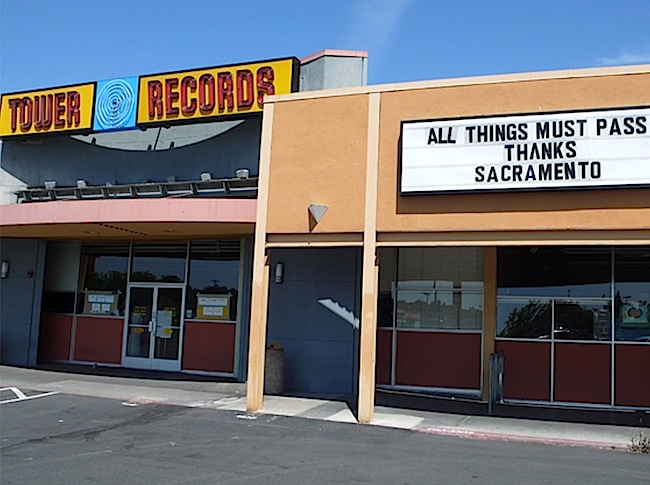
When Tower Records was finally liquidated in 2006, the staff at the chain’s Watt Avenue location put up this sign as a way of explaining and saying goodbye. (Image courtesy Gravitas Ventures)
Around 20 years ago, when Tower was still generating enormous revenues but straining under the weight of its unchecked expansion, Goman thought he saw a way forward. “Russ and I were having argument number 5,250 about used records,” he recalls (in case you’re worried, the two men have remained good friends). “I finally convinced him to do it. We took our Atlanta store and turned it into a store like Amoeba. We moved it from a good location to kind of an off-pitch location, and the business went up about 20 percent. I was trying to do more of those, converting a lot of our stores, especially in the big cities, to that, but then the banks took the business over and that was that. We’d still be around if we could’ve pulled that off.”
“My mistake in the early 2000s was not pursuing the used-record business,” Solomon confirms. “It was beginning to be very profitable. You could buy a used record from the public for anywhere from 50 cents to a buck-and-a-half, and then sell it for $6 or $7. That was pretty good. But the record companies weren’t thrilled with retailers who went into the used business, and we were still focused on maintaining the size of our new-record selection. It’s a sad commentary,” he concludes. “I was buying and selling used records back in 1941, but I never learned how to sell used records again. The used-record guys are still in business.”
Read more of Ben’s work on Collectors’ Weekly. Also on Collectors Weekly: Hippie Daredevils, Psychedelic Rock Posters, and When Pianos Fell From the Sky.
Would you like to support Flashbak?
Please consider making a donation to our site. We don't want to rely on ads to bring you the best of visual culture. You can also support us by signing up to our Mailing List. And you can also follow us on Facebook, Instagram and Twitter. For great art and culture delivered to your door, visit our shop.
